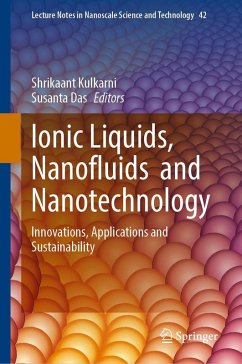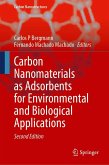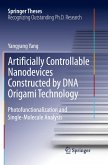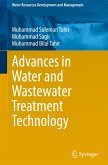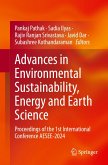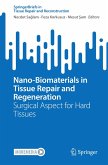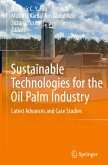Ionic Liquids, Nanofluids and Nanotechnology
Innovations, Applications and Sustainability
Herausgegeben:Kulkarni, Shrikaant; Das, Susanta
Ionic Liquids, Nanofluids and Nanotechnology
Innovations, Applications and Sustainability
Herausgegeben:Kulkarni, Shrikaant; Das, Susanta
- Gebundenes Buch
- Merkliste
- Auf die Merkliste
- Bewerten Bewerten
- Teilen
- Produkt teilen
- Produkterinnerung
- Produkterinnerung
This book provides a comprehensive exploration of the dynamic intersections between ionic liquids (ILs) and nanotechnology. Highlighting innovative strategies for industrial, environmental, and biomedical applications, this book presents insights into the latest research, sustainable solutions, and future prospects, making it a valuable resource for scientists, engineers, and policymakers.
Known as "designer solvents," ionic liquids exhibit exceptional properties like low vapor pressure and high thermal stability, enabling green chemistry applications in chemical synthesis, material design,…mehr
Andere Kunden interessierten sich auch für
![Carbon Nanomaterials as Adsorbents for Environmental and Biological Applications Carbon Nanomaterials as Adsorbents for Environmental and Biological Applications]() Carbon Nanomaterials as Adsorbents for Environmental and Biological Applications129,99 €
Carbon Nanomaterials as Adsorbents for Environmental and Biological Applications129,99 €![Artificially Controllable Nanodevices Constructed by DNA Origami Technology Artificially Controllable Nanodevices Constructed by DNA Origami Technology]() Yangyang YangArtificially Controllable Nanodevices Constructed by DNA Origami Technology76,99 €
Yangyang YangArtificially Controllable Nanodevices Constructed by DNA Origami Technology76,99 €![Advances in Water and Wastewater Treatment Technology Advances in Water and Wastewater Treatment Technology]() Muhammad Suleman TahirAdvances in Water and Wastewater Treatment Technology76,99 €
Muhammad Suleman TahirAdvances in Water and Wastewater Treatment Technology76,99 €![Advances in Environmental Sustainability, Energy and Earth Science Advances in Environmental Sustainability, Energy and Earth Science]() Advances in Environmental Sustainability, Energy and Earth Science129,99 €
Advances in Environmental Sustainability, Energy and Earth Science129,99 €![Nano-Biomaterials in Tissue Repair and Regeneration Nano-Biomaterials in Tissue Repair and Regeneration]() Nano-Biomaterials in Tissue Repair and Regeneration38,99 €
Nano-Biomaterials in Tissue Repair and Regeneration38,99 €![Sustainable Technologies for the Oil Palm Industry Sustainable Technologies for the Oil Palm Industry]() Sustainable Technologies for the Oil Palm Industry106,99 €
Sustainable Technologies for the Oil Palm Industry106,99 €![Chemistry of Renewables Chemistry of Renewables]() Arno BehrChemistry of Renewables77,99 €
Arno BehrChemistry of Renewables77,99 €-
-
-
This book provides a comprehensive exploration of the dynamic intersections between ionic liquids (ILs) and nanotechnology. Highlighting innovative strategies for industrial, environmental, and biomedical applications, this book presents insights into the latest research, sustainable solutions, and future prospects, making it a valuable resource for scientists, engineers, and policymakers.
Known as "designer solvents," ionic liquids exhibit exceptional properties like low vapor pressure and high thermal stability, enabling green chemistry applications in chemical synthesis, material design, and nanotechnology. This book examines ILs in green nanoparticle synthesis, where they offer eco-friendly advantages and precise control over size, shape, and surface chemistry. ILs also play a critical role in nanofluids, improving thermal conductivity, stability, and energy efficiency. Covering topics such as catalysis, environmental remediation, energy storage, and pharmaceuticalapplications, this book also addresses challenges like scalability, toxicity, and green chemistry integration, offering a forward-looking perspective on IL-based nanotechnology.
Known as "designer solvents," ionic liquids exhibit exceptional properties like low vapor pressure and high thermal stability, enabling green chemistry applications in chemical synthesis, material design, and nanotechnology. This book examines ILs in green nanoparticle synthesis, where they offer eco-friendly advantages and precise control over size, shape, and surface chemistry. ILs also play a critical role in nanofluids, improving thermal conductivity, stability, and energy efficiency. Covering topics such as catalysis, environmental remediation, energy storage, and pharmaceuticalapplications, this book also addresses challenges like scalability, toxicity, and green chemistry integration, offering a forward-looking perspective on IL-based nanotechnology.
Produktdetails
- Produktdetails
- Lecture Notes in Nanoscale Science and Technology 42
- Verlag: Springer / Springer Nature Switzerland / Springer, Berlin
- Artikelnr. des Verlages: 89549384, 978-3-032-04007-7
- Seitenzahl: 598
- Erscheinungstermin: 21. November 2025
- Englisch
- Abmessung: 235mm x 155mm
- ISBN-13: 9783032040077
- ISBN-10: 3032040078
- Artikelnr.: 74989907
- Herstellerkennzeichnung
- Springer-Verlag GmbH
- Tiergartenstr. 17
- 69121 Heidelberg
- ProductSafety@springernature.com
- Lecture Notes in Nanoscale Science and Technology 42
- Verlag: Springer / Springer Nature Switzerland / Springer, Berlin
- Artikelnr. des Verlages: 89549384, 978-3-032-04007-7
- Seitenzahl: 598
- Erscheinungstermin: 21. November 2025
- Englisch
- Abmessung: 235mm x 155mm
- ISBN-13: 9783032040077
- ISBN-10: 3032040078
- Artikelnr.: 74989907
- Herstellerkennzeichnung
- Springer-Verlag GmbH
- Tiergartenstr. 17
- 69121 Heidelberg
- ProductSafety@springernature.com
Prof. (Dr.) Susanta Das is a seasoned educator with a proven record of teaching and mentoring diverse students, working at multiple institutions, and providing service to the various initiatives of organizations. He received his Ph.D. and M.A. degrees from Western Michigan University (WMU), USA, and M.Sc. degree from Banaras Hindu University (BHU), India all in Physics. He continued his research as a Marie-Curie post-doctoral fellow at Stockholm University, Stockholm, Sweden on beam diagnostics for the DESIREE (Double ElectroStatic Ion Ring ExpEriment) in the project DITANET (Diagnostic Techniques for particle Accelerators – a Marie-Curie initial training NETwork), at the Indian Institute of Science Education and Research-Kolkata, India on high-pressure physics as a Project Scientist-B, and at the University of Electro-Communications, Tokyo, Japan on ion-surface interactions as a Post-doctoral fellow. Throughout his career, Dr. Das worked and collaborated with many researchers, Ph.D., master, and visiting students from different countries. He further visited many countries to discuss research and an international conference participant (UK, Italy, Germany, Greece, Belgium, Bulgaria, Romania, Brazil etc.). He co-authored several research articles in WoS/Scopus indexed international journals, conference proceedings, and scholarly book chapters published by renowned international publishing houses. Beyond his research endeavors, Dr. Das has a storied history of service to academic and administrative committees, exhibiting his commitment to the growth and development of educational institutions. His experience includes tenure at Central University South Bihar, Sri Sri University, and P.K. University before assuming his current role at Ajeenkya DY Patil University. He received the Marie-Curie post-doctoral fellowship in Sweden, Science Academies’ Summer Research Fellowship in India, Gwen Frostic Doctoral Fellowship, Department Graduate Research and Creative Scholar Award by WMU, and Leo R. Parpart Doctoral Fellowship by Dept. of Physics, WMU, among many others, throughout his academic journey. At present, Dr. Das continues to delve into cutting-edge fields, with a keen interest in nanotechnology, quantum computing, and data science. His multifaceted contributions, spanning teaching, research, and administrative leadership, showcase a dedicated professional who is instrumental in advancing the vision and mission of the institutions he serves. Shrikaant Kulkarni, Ph.D., works as a Research Professor at Sanjivani University, Kopargaon, India, and as an Adjunct Professor at the Faculty of Business, Victorian Institute of Technology, Melbourne, Australia, Adjunct Professor, Lincoln University College, Malaysia, and Adjunct Professor at Chitkara University, Punjab, India. Dr. Kulkarni has been a senior academician and researcher for 42 years. He has delivered invited lectures and conducted sessions at national and international conferences and faculty development programs. He has guided many major and minor projects in areas like engineering chemistry, green chemistry, nanotechnology, analytical chemistry, catalysis, chemical engineering materials, industrial organization, and management, Advanced AI, and Educational Technology. He has published over 100+ research papers in national and international journals and conferences of repute. He has edited 50+ books, including four in Advanced AI, and authored 100+ book chapters in books published by CRC, Springer Nature, Apple Academic Press, Elsevier, Wiley, and IET. He authored four textbooks in engineering chemistry. Dr Kulkarni holds MSc, MPhil, and PhD degrees in Chemistry, as well as Master’s degrees in Economics, Business Management, and Political Science. Two of his Patents have been published, and two more are pending grant. He was invited by UNESCO for an invited talk on “ Green Chemistry Education for Sustainable Development “ at the International Conference on Green Chemistry, Bangkok, and was well received by international Jury members and dignitaries from across the world.
Chapter 1: An Introduction To Ionic Liquids, Nanofluids, Nanomaterials And Nanotechnology.- Chapter 2: Properties And Characterization of Ionic Liquid, Nanofluid And Nanomaterials.- Chapter 3: Harnessing Nanofluids: A Comprehensive Guide To Theory, Synthesis, Properties, And Utilization.- Chapter 4: Foundations And Applications of Ionic Liquids, Nanofluids, Nanomaterials, And Nanotechnology: A Comprehensive Introduction.- Chapter 5: Ionic Liquids: Alternative of Conventional Molecular Solvents For Organic Reactions.- Chapter 6: Bionanofluids: Introduction, Properties, Characterization And Applications.- Chapter 7: Ionic Liquids In Nanofluids: Design And Applications.- Chapter 8: Innovative Biomedical And Clinical Approaches In Ionic Liquids, Nano Fluids And Nanoparticles.- Chapter 9: Biomedical, Biotechnology, Nanobiotechnology, Clinical, Applications of Ionic Liquids, Nanofluids, And Nanoparticles.- Chapter 10: Biomedical, Biotechnology, And Nanobiotechnology Clinical Applications of Ionic Liquids, Nanofluids, And Nanoparticles.- Chapter 11: Biomedical, Biotechnology, Nanobiotechnology, And Clinical Applications of Ionic Liquids, Nanofluids, And Nanoparticles.- Chapter 12: Catalysis Applications of Ionic Liquid Nanoparticles.- Chapter 13: Nanomaterials For Biomedical Sensing: A Focus On Refractive Index-Based Detection Inspired By Dual Self-Referenced Sensors.- Chapter 14: Applications of Nanomaterials/Nanotechnology In Battery, Energy Storage Devices, Supercapacitor, Fuel Cells, Smart Materials Etc.- Chapter 15: Applications of Nanofluids In Energy Storage Devices.- Chapter 16: Effect of Magnetically Controlled Viscosity On Double-Diffusive Convection In Magnetic Nanofluids.- Chapter 17: Synthesis And Antimicrobial Applications of Silver Nanoparticle-Based Nanofluids.- Chapter 18: Ionic Liquids In The Pretreatment of Plant Biomass: Sustainable Pathways For Biorefinery Applications.- Chapter 19: Toxicity of Ionic Liquids, Nanofluids And Nanomaterials/Nanotechnology.- Chapter 20: Advancements In Nanotechnology: The Role of Machine Learning And AI In The Development of Ionic Liquids, Nanofluids, And Bionanofluids.- Chapter 21: Machine Learning And AI In Nanotechnology With Ionic Liquids, Nanofluids And Bio-Nanofluids.- Chapter 22: AI And Machine Learning Applications In Nanotechnology: Advances In Nanofluids, Bio-Nanofluids, And Ionic Liquids.- Chapter 23: Innovations of Machine Learning With Ai Driven Nanotechnology In Ionic Liquids, Nanofluids And Bio Nanofluids.- Chapter 24: Machine Learning And AI In Nanotechnology With Ionic Liquids And Nanofluid And Bionanofluids.- Chapter 25: Challenges, Opportunities, Emerging Trends, Case Studies, Teaching Learning, Protocols, Ethical Issues And Prospects.
Chapter 1: An Introduction To Ionic Liquids, Nanofluids, Nanomaterials And Nanotechnology.- Chapter 2: Properties And Characterization of Ionic Liquid, Nanofluid And Nanomaterials.- Chapter 3: Harnessing Nanofluids: A Comprehensive Guide To Theory, Synthesis, Properties, And Utilization.- Chapter 4: Foundations And Applications of Ionic Liquids, Nanofluids, Nanomaterials, And Nanotechnology: A Comprehensive Introduction.- Chapter 5: Ionic Liquids: Alternative of Conventional Molecular Solvents For Organic Reactions.- Chapter 6: Bionanofluids: Introduction, Properties, Characterization And Applications.- Chapter 7: Ionic Liquids In Nanofluids: Design And Applications.- Chapter 8: Innovative Biomedical And Clinical Approaches In Ionic Liquids, Nano Fluids And Nanoparticles.- Chapter 9: Biomedical, Biotechnology, Nanobiotechnology, Clinical, Applications of Ionic Liquids, Nanofluids, And Nanoparticles.- Chapter 10: Biomedical, Biotechnology, And Nanobiotechnology Clinical Applications of Ionic Liquids, Nanofluids, And Nanoparticles.- Chapter 11: Biomedical, Biotechnology, Nanobiotechnology, And Clinical Applications of Ionic Liquids, Nanofluids, And Nanoparticles.- Chapter 12: Catalysis Applications of Ionic Liquid Nanoparticles.- Chapter 13: Nanomaterials For Biomedical Sensing: A Focus On Refractive Index-Based Detection Inspired By Dual Self-Referenced Sensors.- Chapter 14: Applications of Nanomaterials/Nanotechnology In Battery, Energy Storage Devices, Supercapacitor, Fuel Cells, Smart Materials Etc.- Chapter 15: Applications of Nanofluids In Energy Storage Devices.- Chapter 16: Effect of Magnetically Controlled Viscosity On Double-Diffusive Convection In Magnetic Nanofluids.- Chapter 17: Synthesis And Antimicrobial Applications of Silver Nanoparticle-Based Nanofluids.- Chapter 18: Ionic Liquids In The Pretreatment of Plant Biomass: Sustainable Pathways For Biorefinery Applications.- Chapter 19: Toxicity of Ionic Liquids, Nanofluids And Nanomaterials/Nanotechnology.- Chapter 20: Advancements In Nanotechnology: The Role of Machine Learning And AI In The Development of Ionic Liquids, Nanofluids, And Bionanofluids.- Chapter 21: Machine Learning And AI In Nanotechnology With Ionic Liquids, Nanofluids And Bio-Nanofluids.- Chapter 22: AI And Machine Learning Applications In Nanotechnology: Advances In Nanofluids, Bio-Nanofluids, And Ionic Liquids.- Chapter 23: Innovations of Machine Learning With Ai Driven Nanotechnology In Ionic Liquids, Nanofluids And Bio Nanofluids.- Chapter 24: Machine Learning And AI In Nanotechnology With Ionic Liquids And Nanofluid And Bionanofluids.- Chapter 25: Challenges, Opportunities, Emerging Trends, Case Studies, Teaching Learning, Protocols, Ethical Issues And Prospects.

